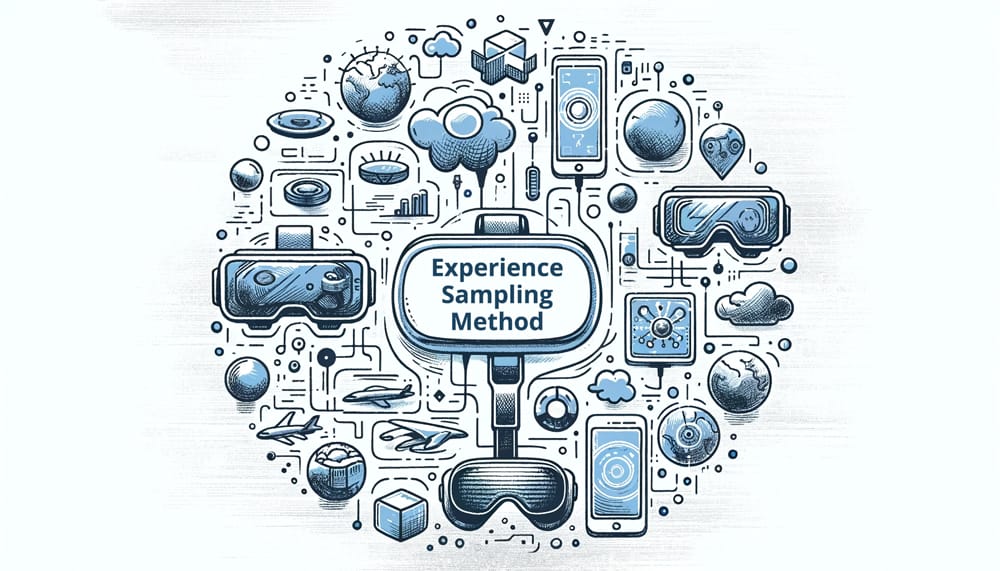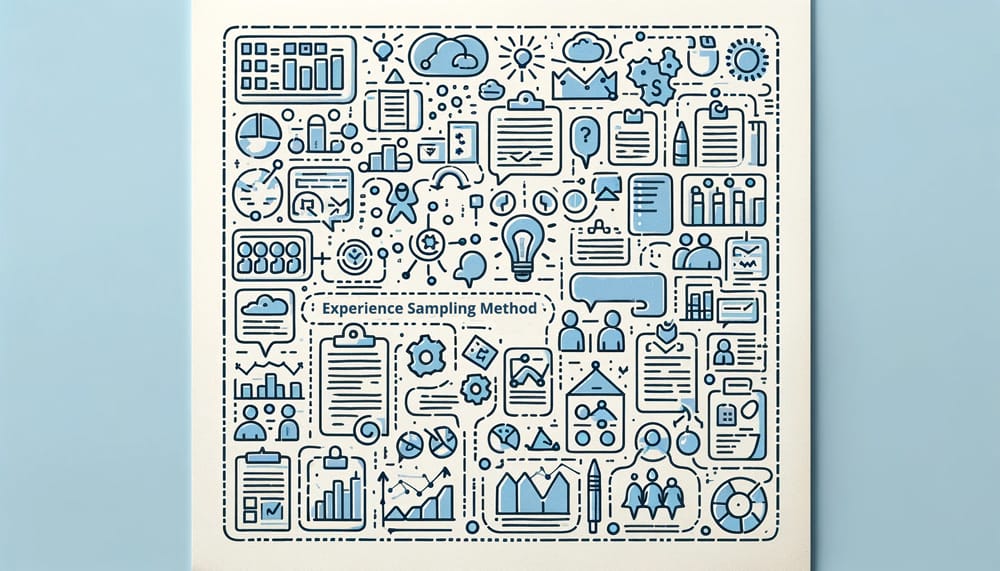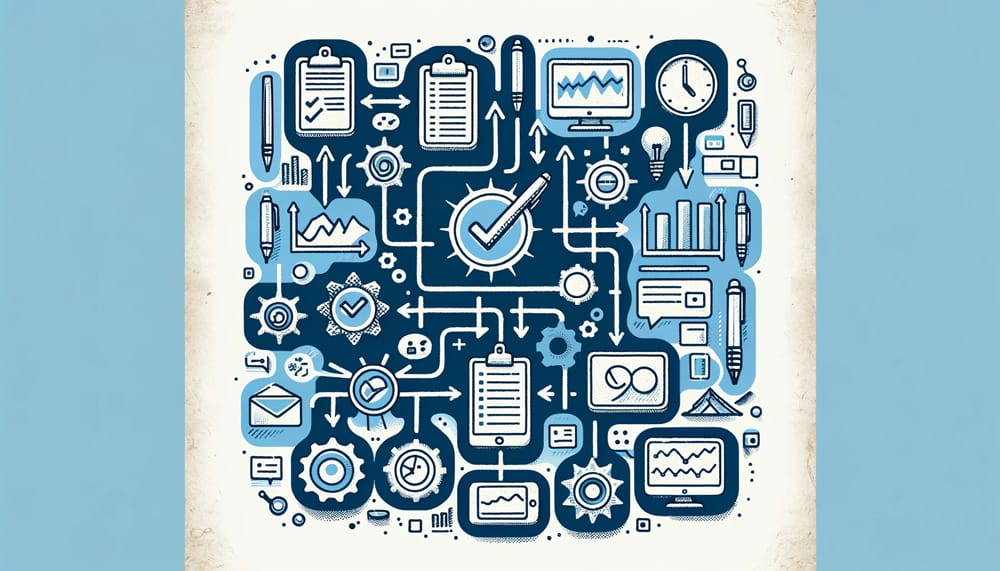Introduction to Technology in ESM
The Evolving Role of Technology in Enhancing ESM Studies
In the dynamic landscape of Experience Sampling Method (ESM) research, technology has emerged as a pivotal force, revolutionizing the way studies are conducted. The integration of technological tools in ESM has transformed traditional methodologies, offering researchers unprecedented capabilities to collect, analyze, and interpret data. This evolution has not only streamlined data collection processes but has also opened new avenues for capturing deeper, more nuanced insights into human experiences.
“In the realm of ESM, technology acts as a bridge, connecting the subtle intricacies of human experiences with the empirical world of data analysis.”
For further insights into the foundational aspects of ESM, Introduction to Experience Sampling Method (ESM) provides a comprehensive overview.
The Importance of Choosing the Right Tools for Research Efficacy
Selecting the appropriate technological tools is critical in maximizing the efficacy of ESM studies. The right tools can significantly enhance the quality and reliability of data, improve participant engagement, and offer sophisticated data analysis capabilities. Key considerations include:
-
- User-friendliness: Tools should be accessible and easy to use for participants, ensuring high response rates and quality data.
-
- Customizability: The ability to customize tools to fit specific research needs is essential for capturing data that is most relevant to the study’s objectives.
-
- Data Security: With the increasing focus on digital data collection, ensuring the security and privacy of participant data is paramount.
-
- Integration Capabilities: The potential to integrate with other software and data sources can greatly expand the scope and depth of ESM research.
Choosing the right technological tools requires a careful balance between functionality, user experience, and data integrity. It’s about finding a solution that not only aligns with the study’s goals but also respects and protects the participants’ experiences and contributions.
For a deeper dive into the world of ESM technology, resources like Technological Innovations in ESM Data Collection provide comprehensive insights into the latest tools and how they are shaping the future of ESM research.
In conclusion, the integration of technology in ESM is a testament to the field’s continuous evolution, offering researchers powerful tools to gain a deeper understanding of human experiences. The choice of technology in ESM studies is a crucial decision that significantly influences the study’s success and the richness of the insights gleaned.
Overview of Current Technological Tools in ESM

A Comprehensive Look at the Latest Tools and Software
The landscape of Experience Sampling Method (ESM) research is continually enhanced by technological advancements. These tools and software solutions are designed to improve the efficiency and effectiveness of data collection, analysis, and interpretation. Here’s an overview of some of the latest tools and software in ESM:
- ESM-specific Mobile Apps: There are several mobile applications specifically designed for ESM studies. These apps allow for the scheduling and delivery of prompts, real-time data collection, and often include features for response tracking and reminders.
- Wearable Devices: Wearables, like smartwatches and fitness trackers, are increasingly being used in ESM research. They are particularly useful for collecting physiological data such as heart rate, activity levels, and sleep patterns, alongside subjective self-report data.
- Data Analysis Software: Advanced software tools are available for the analysis of ESM data. These tools offer functionalities for processing large datasets, identifying patterns, and visualizing data in meaningful ways.
- Cloud-based Platforms: Cloud-based ESM platforms provide centralized data management solutions. They facilitate data storage, ensure security, and offer remote access for both researchers and participants.
- Customizable Survey Platforms: Several platforms offer customizable survey tools, allowing researchers to tailor the ESM experience to their specific study needs. These can range from simple questionnaires to more complex, branching surveys.
Features and Functionalities Benefiting ESM Research
These technological tools come equipped with a range of features and functionalities that cater specifically to the needs of ESM research:
-
- Automated Prompt Delivery: Many apps and software allow for the automated scheduling and delivery of prompts, ensuring timely and consistent data collection.
-
- Real-time Data Collection: The ability to collect data in real-time is crucial for capturing the momentary experiences and responses that are central to ESM studies.
-
- Integration of Multiple Data Types: Modern ESM tools can integrate various types of data, from self-reports to physiological measures, offering a more holistic view of the research subject.
-
- Data Security and Compliance: Given the sensitivity of the data often collected in ESM studies, these tools prioritize security measures and compliance with data protection regulations.
-
- User Engagement Features: To maintain participant engagement, many tools include interactive and user-friendly interfaces, along with features like gamification and personalized feedback.
For an in-depth exploration of the latest ESM tools and their applications, Technological Innovations in ESM Data Collection offers valuable insights and examples.
In summary, the current landscape of technological tools in ESM is diverse and robust, offering a wide range of solutions to meet the varying needs of researchers. From sophisticated mobile apps to wearable devices and advanced data analysis software, these tools not only streamline the research process but also open up new possibilities for deeper and more comprehensive insights into human experiences.
Choosing the Right ESM Software

Criteria for Selecting Software That Fits Your Research Needs
When embarking on an Experience Sampling Method (ESM) study, the selection of the right software is a pivotal decision. This choice should be guided by a set of criteria that ensures the software aligns perfectly with your research objectives and methodology.
- Functionality: Look for software that offers features crucial to your ESM study, like customizable surveys, scheduling capabilities, and diverse data collection methods.
- User Experience: An intuitive interface is key for both researchers and participants. Ease of use leads to better engagement and more reliable data.
- Data Management and Analysis: Prioritize software with efficient data management and powerful analysis tools. It should facilitate easy data export and be compatible with advanced statistical software.
- Customization: The ability to tailor the software to your study’s specific needs – from questionnaires to notification schedules – is essential.
- Cost: Balance the software’s features with your budget. The most expensive option isn’t always the best for your needs.
- Support and Reliability: Opt for software backed by strong customer support and a proven track record of reliability.
- Ethical Compliance: Ensure the software adheres to ethical standards, particularly concerning data security and participant privacy.
“The right ESM software should not only meet your study’s specific needs but also ensure a balance between functionality, user experience, and ethical compliance.”
In conclusion, choosing the right ESM software is a nuanced decision that impacts the overall efficacy and integrity of your ESM study. By carefully weighing these criteria and comparing the leading platforms, you can select a tool that not only enhances your research but also upholds the highest standards of data quality and ethical practice.
For more detailed strategies on handling these challenges, researchers can refer to resources such as Challenges and Solutions in ESM Research.
Mobile and Wearable Technology in ESM

Exploring the Use of Mobile and Wearable Devices in ESM
The integration of mobile and wearable technologies in Experience Sampling Method (ESM) research has opened new horizons in data collection and participant engagement. These technologies offer a more dynamic and real-time approach to capturing experiences as they occur.
Mobile Devices: Mobile phones, with their ubiquitous presence in our daily lives, serve as an ideal tool for ESM studies. Their portability and connectivity allow for the prompt delivery of surveys and real-time data collection. Studies have shown that using mobile phones in ESM research can lead to higher response rates and more accurate data, as discussed in Improving Compliance in ESM Data Collection.
Wearable Devices: Wearables, like smartwatches and fitness trackers, bring a new dimension to ESM by providing continuous physiological data. They can track heart rate, sleep patterns, and physical activity, offering valuable context to the subjective data collected through surveys. This integration of qualitative and quantitative data is crucial in fields like mental health research.
Advantages and Challenges of Integrating These Technologies
Advantages:
- Real-Time Data Collection: Both mobile and wearable devices enable the collection of real-time data, capturing experiences as they occur.
- Increased Participant Engagement: The convenience and familiarity of these devices can lead to higher engagement and compliance rates.
- Rich Data Sets: The combination of subjective survey responses with objective physiological data from wearables provides a comprehensive view of the participant’s experiences.
- Contextual Relevance: Mobile and wearable technologies offer contextual data, like location and physical activity, enhancing the depth of the analysis.
Challenges:
- Data Privacy and Security: Ensuring the security and privacy of the data collected through these devices is paramount. Ethical considerations must be addressed, as outlined in Ethical Considerations in ESM Research.
- Technical Limitations: Issues like battery life, data storage, and the need for continuous internet connectivity can pose challenges.
- Participant Accessibility: There may be limitations in terms of participant access to these technologies, potentially leading to a selection bias in the study sample.
- Data Overload: The vast amount of data collected from these devices requires efficient data management and analysis strategies, as discussed in Analyzing ESM Data: A Guide.
In conclusion, while the integration of mobile and wearable technologies in ESM research offers significant advantages in terms of data richness and real-time collection, it also brings challenges that require careful consideration and strategic planning. Balancing these advantages and challenges is key to leveraging the full potential of these technologies in ESM studies.
Customizing Technology for Your ESM Study

Tailoring Technological Tools to Fit Specific Study Requirements
Customizing technology in Experience Sampling Method (ESM) research is crucial for addressing the unique needs of each study. Tailoring technological tools involves several key steps:
- Identifying Specific Needs: Begin by clearly defining the goals and requirements of your study. This could involve specific types of data, frequency of data collection, or unique participant interactions.
- Choosing the Right Platform: Select a platform that offers the level of customization you need. Some ESM software allows for extensive modification in survey design, notification scheduling, and data collection methods.
- Integrating Diverse Data Sources: In many studies, combining data from multiple sources, such as self-reports, physiological data, and environmental information, is essential. Choose technology that can integrate and synchronize these different data streams.
- Developing Custom Features: Sometimes, your study might require the development of custom features. Work with software developers to create these features, ensuring they align with your research objectives and participant needs.
- Testing and Iteration: Before full deployment, test the customized tool with a small group. Use the feedback to make necessary adjustments, ensuring the technology is intuitive and effective.
For a deeper understanding of how random sampling integrates into the broader context of ESM research, resources such as Technological Innovations in ESM Data Collection can be immensely helpful. They provide insights into how modern technologies can aid in efficiently implementing random sampling techniques.
Data Security and Privacy Concerns

Addressing Data Security and Privacy in the Use of ESM Technology
In the realm of Experience Sampling Method (ESM) research, data security and privacy are paramount, especially given the personal nature of the data collected. Researchers must take proactive steps to ensure that all participant information is protected.
- Data Encryption: Implement strong encryption protocols for both data in transit and at rest. This prevents unauthorized access to sensitive information.
- Secure Data Storage: Use secure, compliant servers for data storage. Cloud storage options should comply with industry standards like GDPR or HIPAA, as relevant.
- Anonymization of Data: Where possible, anonymize participant data. This involves removing or altering personal identifiers to prevent tracing data back to individuals.
- Regular Security Audits: Conduct regular security audits of the ESM software and data storage systems to identify and address potential vulnerabilities.
- Participant Consent: Ensure informed consent is obtained from all participants. This includes clearly explaining how their data will be used, stored, and protected, as emphasized in Ethical Considerations in ESM Research.
Best Practices for Safeguarding Participant Data
Implementing best practices for data security and privacy is critical in maintaining the integrity of the research and the trust of participants.
-
- Use of Reliable Platforms: Opt for ESM platforms known for their strong security measures. Research and select platforms that prioritize data protection, as discussed in Technological Innovations in ESM.
-
- Training and Awareness: Train all research team members on data security and privacy protocols. Awareness about potential risks and how to avoid them is crucial.
-
- Access Controls: Limit access to sensitive data. Only authorized personnel should be able to access participant data, and they should be trained in handling confidential information.
-
- Regular Updates and Maintenance: Keep all software up to date. Regular updates often include patches for security vulnerabilities.
-
- Transparency with Participants: Maintain transparency with participants about how their data is being used and protected. This builds trust and ensures ethical compliance.
By adhering to these practices and continually staying informed about the latest in data security and privacy, researchers can ensure that their ESM studies not only produce valuable insights but also maintain the highest standards of data protection.
Conclusion: Integrating Technology Effectively
The integration of technology into Experience Sampling Method (ESM) studies has revolutionized the way researchers collect and analyze data. From mobile and wearable devices offering real-time data capture to customized software solutions tailored to specific research needs, technology has opened up new possibilities in ESM research.
Key Points on Integrating Technology in ESM:
-
- Embrace Mobile and Wearable Technologies: Utilize the ubiquity and capabilities of these devices for richer, more contextual data collection.
-
- Customization is Key: Tailoring technology to fit the specific requirements of your study enhances data accuracy and participant engagement.
-
- Prioritize Data Security and Privacy: Implement robust data protection measures to maintain the integrity of the research and trust of participants.
Optimizing ESM Studies with Current Tools: Utilizing the latest tools and technologies requires a balance between innovative data collection methods and ethical considerations. Researchers should strive for a synergy between technological capabilities and the study’s objectives, ensuring that the technology serves the research and not the other way around.
“The effective integration of technology in ESM research is not just about adopting new tools; it’s about enhancing the depth and quality of the data we collect, while safeguarding the privacy and trust of our participants.”
You Might Also Be Interested:
Delve into our comprehensive ESM Article Collection for insightful perspectives on Experience Sampling Method (ESM).
See our article Best Tools for Experience Sampling Method in 2024 to discover the top tools in the field.
Learn how the advanced features of Fibion Insight can aid your ESM research.
Planning an ESM study? For a chat with our ESM expert, book a session with Dr. Miriam Cabrita.
Frequently asked questions about this topic
What is the role of technology in Experience Sampling Method (ESM) research?
Technology plays a pivotal role in ESM research, transforming traditional methodologies and enhancing capabilities in data collection, analysis, and interpretation.
What should researchers consider when choosing technological tools for ESM studies?
Researchers should consider user-friendliness, customizability, data security, and integration capabilities when selecting technological tools for ESM studies.
What are some current technological tools used in ESM research?
Current tools include ESM-specific mobile apps, wearable devices, data analysis software, cloud-based platforms, and customizable survey platforms.
How do mobile and wearable technologies enhance ESM research?
Mobile and wearable technologies enable real-time data collection, increase participant engagement, provide rich data sets, and offer contextual relevance.
What are the challenges in integrating mobile and wearable technologies in ESM?
Challenges include data privacy and security, technical limitations, participant accessibility, and managing data overload.
Why is data security and privacy important in ESM technology use, and how can it be ensured?
Data security and privacy are crucial due to the personal nature of data collected. This can be ensured through data encryption, secure data storage, anonymization of data, regular security audits, and participant consent.


 Delve into our comprehensive
Delve into our comprehensive  See our article
See our article  Learn how the advanced features of
Learn how the advanced features of  Planning an ESM study? For a chat with our ESM expert,
Planning an ESM study? For a chat with our ESM expert, 








